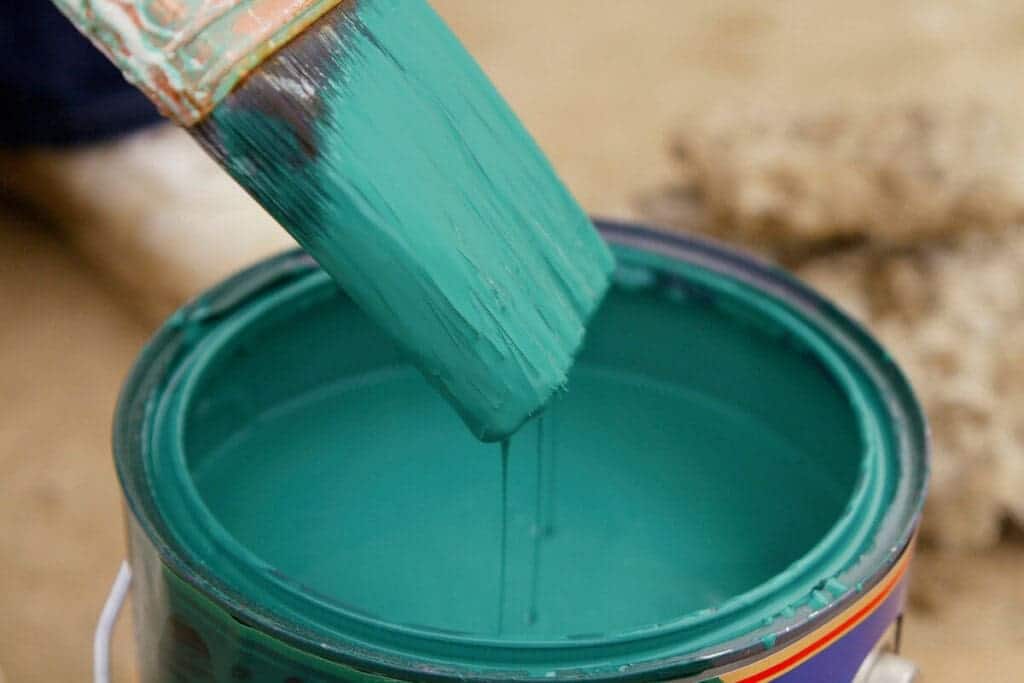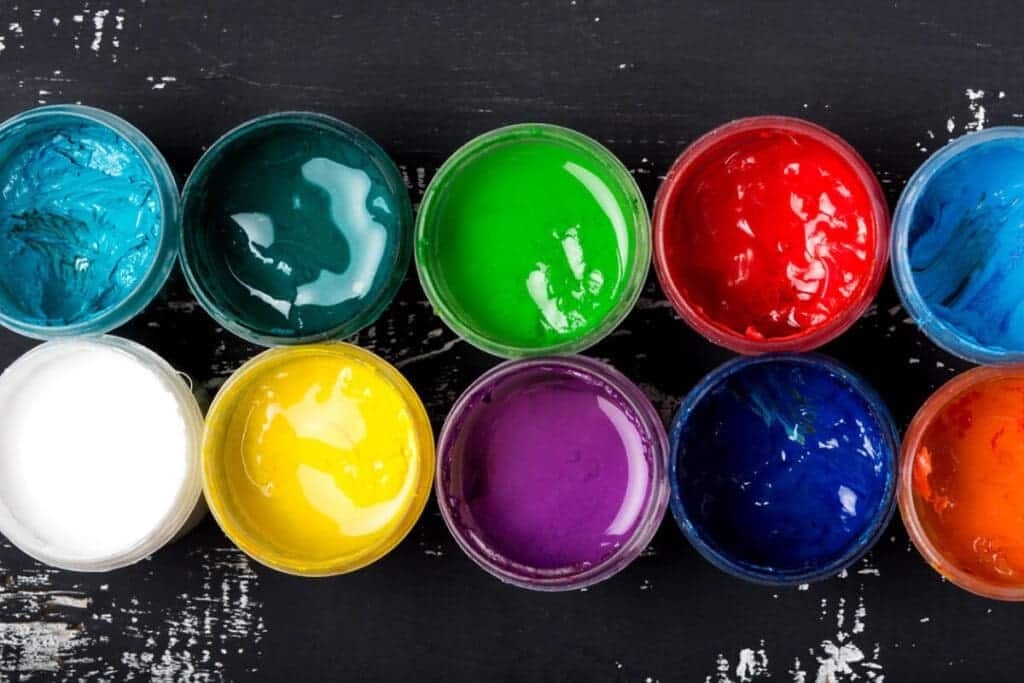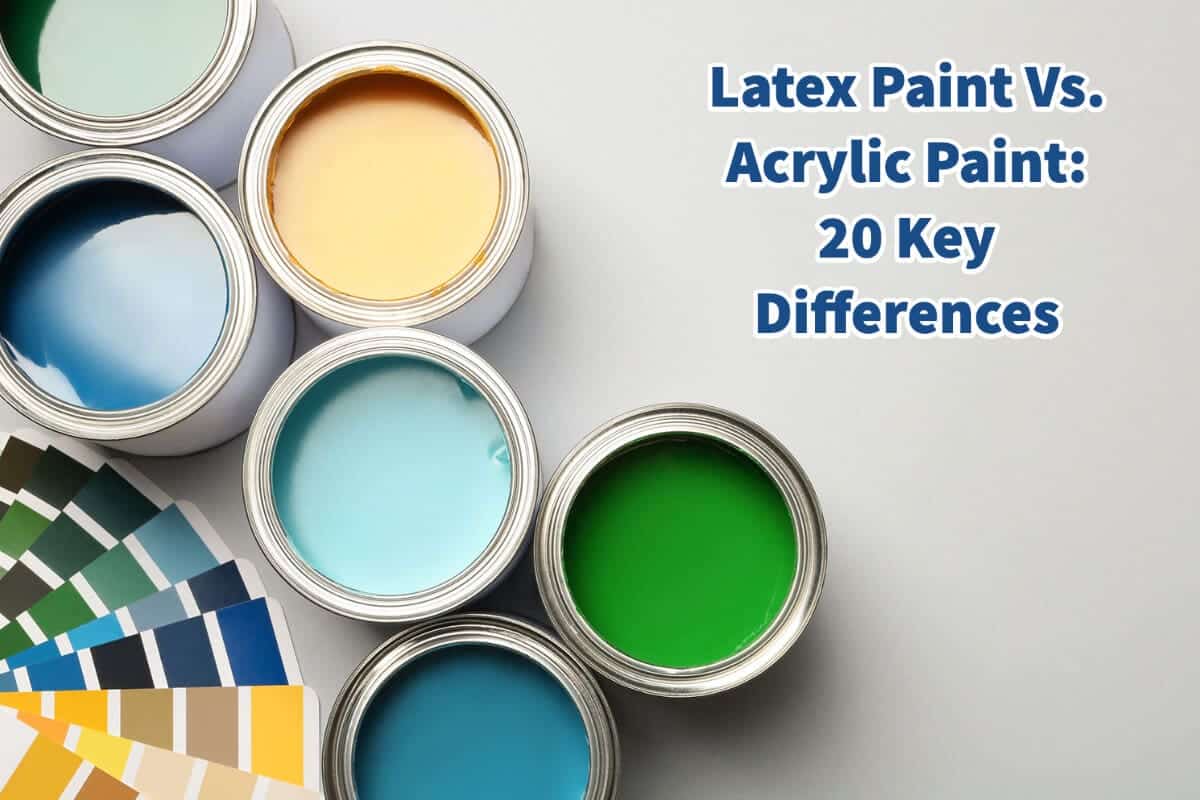When it comes to painting projects, whether for your home’s interior, exterior, or art projects, the choice of paint can make all the difference. Two of the most popular paints are latex and acrylic.
Two types stand out as the most recognized when exploring the world of paints: latex and acrylic paint. While these paints might appear similar at first glance, they possess distinct differences. Join us as we delve into the definitions of each paint and highlight their unique characteristics.
Table of Contents
- What Is Latex Paint?
- What Is Acrylic Paint?
- 20 Key Differences Between Latex And Acrylic Paints
- Frequently Asked Questions
- Related Content
What Is Latex Paint?
Latex paint is one of the most popular in household and commercial applications. Contrary to its name, latex paint does not contain natural rubber latex.
Instead, the term ‘latex’ in this context refers to the water-based characteristic of the paint, signifying its ability to be dispersed in water. Essentially, the name indicates the paint’s liquid vehicle and denotes its primary solvent as water, distinguishing it from oil-based paints.

The main components of latex paint are water, pigments, and binders, with other additives included to provide specific characteristics like improved drying time, consistency, and finish. The binder in latex paints is typically a form of acrylic or vinyl. This gives the paint its adhesion and durability once it dries.
The water is a carrier for the pigment and binder, ensuring easy application. As the paint dries, the water evaporates, leaving behind a binder film and pigment on the painted surface.
One of the primary reasons for latex paint’s widespread popularity is its user-friendly nature. It dries relatively quickly, emits a minimal odor, and can be cleaned quickly using soap and water. Additionally, modern latex paints offer excellent color retention and resist yellowing.
They are environmentally preferred due to their low volatile organic compound (VOC) content, which means they release fewer pollutants into the air as they dry. With a broad range of finishes available, from matte to glossy, latex paint is versatile enough to meet the requirements of diverse painting projects.
What Is Acrylic Paint?
Acrylic paint is a versatile and popular medium used by artists and DIY enthusiasts alike, known for its vibrant colors and adaptability to various techniques. The primary composition of acrylic paint involves pigments suspended in an acrylic polymer emulsion.
As the paint dries, the water in the emulsion evaporates, resulting in a durable, flexible, and water-resistant film.
Introduced in the mid-20th century, acrylic paint quickly gained traction due to its unique properties. Unlike oil paints, which can take days or even weeks to dry completely, acrylics can dry in as little as 20 minutes to an hour, depending on the thickness of the application and environmental conditions.
This rapid drying time allows artists to layer colors swiftly or continue working on a piece without lengthy interruptions.

One of the defining characteristics of acrylic paint is its incredible versatility. It can be thinned with water or an acrylic medium to resemble the consistency of watercolors or applied thickly, much like oil paints.
When thinned, it offers a translucent quality, but in its undiluted form, it is opaque, allowing artists to play with textures and techniques like impasto, glazing, and dry brushing.
Another advantage of acrylic paint is its permanence. Once it dries, it becomes water-resistant, making layering effortless without the risk of reactivating the underlying paint. Furthermore, it doesn’t yellow over time, ensuring that artworks remain vibrant and authentic to their original colors for years.
Ease of cleanup is another appealing feature. While oil paints require solvents like turpentine for cleanup, brushes, and tools used with acrylics can be cleaned with simple soap and water if the paint hasn’t dried completely. However, it’s crucial to note that while wet acrylic is water-soluble, once dried, it is permanent.
Overall, acrylic paint offers a blend of traditional and modern painting properties, making it a favored choice for beginners and seasoned artists. Whether used on canvas, paper, wood, or fabric, its flexibility and durability ensure it has a firm place in art.
20 Key Differences Between Latex And Acrylic Paints
Latex and acrylic paints have several fundamental differences. They are distinct and not interchangeable.
Here are 20 key differences between latex and acrylic paint.
Origin:
- Latex: Unlike its name, latex paint doesn’t contain natural rubber latex. The term ‘latex’ refers to the water-based nature of the paint and its ability to be dispersed in water.
- Acrylic: Acrylic paint is made of pigments suspended in an acrylic polymer emulsion.
Primary Use:
- Latex: Predominantly used for home interiors and exteriors.
- Acrylic: Favoured for artistic applications on canvas and other mediums.
Durability:
- Latex: Generally less durable compared to acrylic. Suitable for low-traffic areas.
- Acrylic: Highly durable, can withstand harsh weather, and resist fading.
Finish:
- Latex: Offers various finishes, including matte, semi-gloss, and glossy.
- Acrylic: Typically provides a glossy finish, but matte and other finishes can be achieved with additives.
Drying Time:
- Latex: Dries relatively quickly, usually in 1-2 hours.
- Acrylic: Can dry in as little as 20 minutes.
Flexibility:
- Latex: Less flexible; might crack under pressure or with temperature changes.
- Acrylic: More flexible, expands, and contracts with surfaces, reducing the likelihood of cracking.
Environmental Impact:
- Latex: Often has fewer volatile organic compounds (VOCs), making it more eco-friendly.
- Acrylic: While low-VOC options exist, traditional acrylics can have higher VOC content.
Cleanup:
- Latex: Easily cleaned with soap and water.
- Acrylic: Requires a solvent like denatured alcohol for cleanup.
Odor:
- Latex: Low odor, especially the low-VOC varieties.
- Acrylic: Might have a stronger odor due to the solvents involved.
Color Retention:
- Latex: Might be yellow over time, especially in low-light conditions.
- Acrylic: Excellent color retention; resistant to yellowing.
Breathability:
- Latex: More breathable, allows walls to release moisture.
- Acrylic: Less breathable and can trap moisture.
Water Resistance:
- Latex: Water-resistant but not ideal for very damp conditions.
- Acrylic: Highly water-resistant, often used in areas prone to moisture.
Stain Resistance:
- Latex: Generally resistant to stains but might require a separate primer.
- Acrylic: Inherently resistant to stains and often doesn’t require a primer.
UV Resistance:
- Latex: Can be affected by prolonged UV exposure.
- Acrylic: Highly UV-resistant, great for sunny environments.
Adhesion:
- Latex: Adheres well to porous surfaces.
- Acrylic: Strong adhesion to a wide range of surfaces.
Price:
- Latex: Typically less expensive.
- Acrylic: It might be pricier, mainly artist-grade acrylics.
Lifespan:
- Latex: Fewer years; may need repainting sooner.
- Acrylic: Can last for decades without significant wear or color fading.
Mixing:
- Latex: Doesn’t mix well with oil-based paints.
- Acrylic: Versatile; can be mixed with various mediums for desired effects.
Consistency:
- Latex: Thinner consistency.
- Acrylic: It can be thick and heavy-bodied, but its consistency varies across brands.
Toxicity:
- Latex: Generally non-toxic.
- Acrylic: Some may contain harmful chemicals; using them in well-ventilated areas is essential.
Both latex and acrylic paints have their advantages and are tailored for specific purposes. Your choice should depend on your project’s nature, budget, and desired finish.
Whether painting your living room wall or creating a masterpiece on canvas, knowing the difference between these paints will ensure the best results for your endeavor.
At Mondoro, we would love to help you decide which finish would be best for manufacturing your home decor and furniture product.
Find out more about how Mondoro can help you create, develop, and manufacture excellent home decor and home furniture products – including lacquer home decor and furniture. Don’t hesitate to contact me, Anita. Check out my email by clicking here or become a part of our community and join our newsletter by clicking here.
Mondoro gives out a FREE Lookbook to anyone interested. You can receive a copy of our latest Lookbook by clicking here.
Listen to our Podcast called Global Trade Gal. You can find it on all major podcast platforms. Try out listening to one of our podcasts by clicking here.
Subscribe to our Mondoro Company Limited YouTube Channel filled with great videos and information by clicking here.
Frequently Asked Questions
What is Latex Paint?
Latex paint is a water-based paint that uses a synthetic latex binder. It is commonly used for interior and exterior surfaces in homes.
What is Acrylic Paint?
Acrylic paint, on the other hand, is water-based and uses acrylic resin as a binder. It is popular in both artistic and home improvement applications.
Are Latex and Acrylic Paints Interchangeable?
While they are both water-based paints, latex paint uses a different type of binder (latex), while acrylic paint uses acrylic resin.
Can Latex and Acrylic Paints be Interchanged?
In most cases, yes. Latex and acrylic paints are often interchangeable, but specific projects may benefit from one over the other based on their unique characteristics.
Which Paint Dries Faster?
Acrylic paint generally dries faster than latex. This quick drying time makes acrylic a preferred choice for artistic projects.
Is Latex Paint Environmentally Friendly?
Yes, latex paint is considered more environmentally friendly as it has lower levels of toxic emissions compared to oil-based paints.
What Surfaces are Suitable for Latex Paint?
Latex paint adheres well to surfaces like drywall, wood, and masonry. It’s commonly used for interior walls and ceilings.
Can Acrylic Paint be Used Outdoors?
Yes, acrylic paint is suitable for outdoor use. It forms a durable finish that resists fading and can withstand exposure to the elements.
How Do They Differ in Terms of Flexibility?
Latex paint typically provides better coverage in fewer coats. However, acrylic paint can also offer excellent coverage, especially for artistic applications.
Can Latex and Acrylic Paints be Mixed?
While it’s generally not recommended to mix different types of paints, some artists and DIYers experiment with mixing latex and acrylic paints. However, results may vary, and it’s advised to test on a small area first.
Related Content
Lacquerware And Mother Of Pearl – 10 Reasons We Love Them!
We love lacquerware and mother-of-pearl products. Lacquerware and mother of pearl are high-quality handmade products that can produce a variety of finishes and techniques in various shapes and sizes. You can use the materials for all kinds of home decor and home furniture products.
You can discover more by reading Lacquerware And Mother Of Pearl – 10 Reasons We Love Them! by clicking here.
The Pros And Cons Of Lacquer Vs. Enamel Finishes
Lacquer and enamel are popular finishes used in various applications, from woodwork and furniture to cars and machinery. While both can provide a glossy finish, they differ in composition, durability, and application.
You can discover more by reading The Pros And Cons Of Lacquer Vs. Enamel Finishes by clicking here.
About Vietnamese Lacquer Furniture And Accessories
Vietnamese lacquer requires many manufacturing steps in the lacquer production process, including making the base, preparing the lacquer base to be applied, and finally, using the lacquer paint on the surface. Every piece must be carefully sanded to give it a very smooth surface. Vietnamese lacquerware production requires a lot of skill and knowledge.
To learn more, you can read About Vietnamese Lacquer Furniture And Accessories by clicking here.

